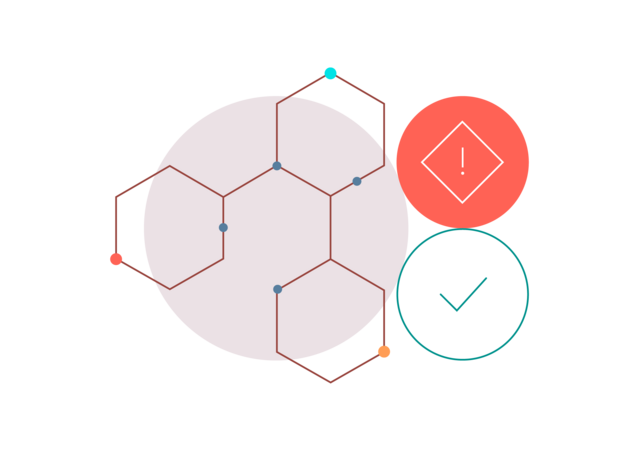The success and acceptance of consumer packaged goods (CPG) companies in global markets require a collaborative effort. Each step of the supply chain — from raw materials procurement to retail — must meet regulatory requirements, key product specifications and consumer expectations. Effective communication along the supply chain and internally is essential as companies navigate these shifting demands and requirements.
Keep reading to explore what are the driving forces of the accelerating importance of communication, transparency and compliance along the supply chain.
Evolving chemical legislation and compliance requirements
Companies must comply with a growing number of regulations aimed at protecting people and the environment against potential risks associated with the chemicals used in the manufacturing of their products. These regulations vary based on the product category of the global markets in which they are sold.
Key federal chemical regulations
For example, food contact materials comprise a wide range of products, including food packaging, manufacturing machinery, conveyor belts, consumer kitchen goods, as well as materials such as plastics, papers and adhesives. The Framework Regulation (EC) No 1935/2004 and the Good Manufacturing Practice (GMP) Regulation (EC) No 2023/2006 are examples of regulations addressing the safety of materials and articles in Europe. In the United States, food contact materials must comply with Title 21 of the U.S. Code of Federal Regulations (21 CFR).
Cosmetic products also face increasing regulatory requirements. Modernization of Cosmetics Regulation Act of 2022 (MoCRA) brought about the most significant expansion of the U.S. Food and Drug Administration’s (FDA’s) authority to regulate cosmetics since the Federal Food, Drug, and Cosmetic (FD&C) Act was passed in 1938. Among these updates, MoCRA requires the FDA to develop regulations establishing and requiring standardized testing methods for detecting and identifying asbestos in talc-containing cosmetic products. The regulation also expands the FDA’s authority to include facility registration, whereby cosmetic product manufacturers and processors must register their facilities with the FDA, update the registration within 60 days of any change, and renew their registration every two years.
A third CPG product category impacted by federal chemical compliance legislation is children’s and juvenile products, which include a broad range of products from toys and stationary activity centers to cribs and toddler beds. The U.S. Consumer Product Safety Commission (CPSC) is an independent U.S. government agency that aims to protect the public from unreasonable risks of serious injury or death resulting from thousands of types of consumer products under its jurisdiction, including products that pose fire, electrical, chemical or mechanical hazards as well as products that can injure children. Much of CPSC’s authority is established by the Consumer Product Safety Act (CPSA), under which standards and bans can be enacted. After the passage of the Consumer Product Safety Improvement Act (CPSIA) in 2008, the requirements for children’s products were reformed, and new regulatory requirements and penalties for noncompliance were added. Children’s products were also defined to include “any consumer product designed or intended primarily for use by children aged 12 or younger.” Manufacturers must demonstrate that products sold in the U.S. comply with CPSIA. Because of this, CPSIA testing is a critical step in going to market for companies that sell children’s products.
Repercussions of noncompliance
Although conditions of compliance vary by industry, location and regulation, chemical compliance for consumer goods manufacturers generally entails written documents stating that products comply with applicable regulations. Companies must also provide appropriate supporting documentation and traceability and should be able to identify the previous and next steps in the supply chain. When products and materials are found to be out of compliance with these regulations, companies can face significant negative consequences, including:
- Notices of noncompliance, penalties and fines from regulatory bodies
- Delayed shipments
- Obstacles in accessing target markets and key retailers
- Extra time and costs incurred by additional testing
- Product recalls
- Brand damage
Growing consumer awareness
Federal regulations are not the only chemical data management drivers for CPG companies. Consumers have a greater awareness of chemicals today than ever before. “Chemical” is often sensationalized as a bad word by the media, which impacts public perception of certain products and ingredients.
These influencers not only raise our awareness of how the products we use can impact the health and well-being of people and the planet, they drive regulation, particularly at the state level in the U.S. For example, California Proposition 65 (Prop 65), also known as the Safe Drinking Water and Toxic Substances Act of 1986, was enacted with the goal of protecting drinking water from toxic chemicals. Prop 65 requires businesses to warn Californians about significant exposures to chemicals that have been shown to cause cancer, birth defects or other reproductive harm. It also requires California to publish and annually update the list of these chemicals. Prop 65 applies to all consumer products.
An intensifying need to go beyond regulations
Consumer watchdogs and nongovernmental organizations (NGOs) are also publicly putting pressure on companies to look for safer, more environmentally sustainable alternatives in the manufacture of their products. As a result of heightened public awareness and scrutiny of chemicals is that consumer goods manufacturers and brands are encouraged to adopt chemical management policies even when they are not enforced by federal or state regulations to meet consumer expectations and protect their brand reputation. In order to satisfy consumers and stand out from their competition, companies must go above and beyond the regulations to avoid potential scrutiny and to access key retailers that may have comprehensive restricted substance lists (RSLs) for food and food contact products to be allowed on their shelves.
Obstacles to communication and compliance
These driving forces underline the importance of chemical compliance management and product stewardship to the success of CPG companies. Such efforts require companies to foster collaboration both internally (between regulatory compliance and quality teams, for instance) and along the entire supply chain. CPG companies often face obstacles in obtaining accurate and sufficient chemical compliance data from their suppliers, and these insufficiencies usually stem from the following issues:
- Regulatory knowledge gaps – Suppliers, especially smaller suppliers, may have gaps in their knowledge base of regulatory requirements for restricted substances, which may result in their ignoring your request. Providing your suppliers with a high-level overview of the regulations, their requirements and the reason for your request can help educate your suppliers about your expectations so they can provide the information you need.
- Lack of transparency or traceability further upstream – Suppliers may be just starting out on their own compliance journey or they may have limited insight into the sourcing of raw materials for their materials and formulations.
- Supplier fatigue – Suppliers frequently receive requests for information from many different sources through email, phone calls and faxes. They also receive abundant internal requests as well. Suppliers may not respond in a timely manner because your request is buried in a very deep pile of requests.
- Supplier human resources issues – Your contact person at your supplier may be filling many roles in their organization. When suppliers are stretched so thin, they may have trouble keeping up with chemical compliance data requests.
Improving with UL Solutions chemical compliance management software and services
Companies must strive to not only stay informed of regulations applicable to their product but also train and educate their suppliers about regulatory requirements and expectations. To help improve the quality of chemical compliance data companies receive from their suppliers, companies must communicate clearly and consistently. Chemical compliance activities require clear and consistent communication along your supply chain.
Using a chemical compliance management platform, such as UL Solutions’ suite of chemical compliance management software and services, can help companies streamline and strengthen compliance activities and communication along the supply chain. Rather than keeping track of many spreadsheets and emails, users from across your organization, anywhere in the world, can use our platform to access compliance data. Our database of chemical legislation, regularly analyzed and updated by global regulatory experts, is searchable to help you save time researching current regulations. You can efficiently survey all of your suppliers, assess formulations against regulations, create and distribute compliance documents, and more.
UL SOLUTIONS AND THE UL SOLUTIONS LOGO ARE TRADEMARKS OF UL LLC © 2023. ALL RIGHTS RESERVED. THIS DOCUMENT MAY NOT BE COPIED WITHOUT WRITTEN PERMISSION FROM UL LLC AND ONLY IN ITS ENTIRETY. THE DOCUMENT IS FOR GENERAL INFORMATION PURPOSES ONLY AND IS NOT INTENDED TO CONVEY LEGAL OR OTHER PROFESSIONAL ADVICE. THE INFORMATION PROVIDED IN THIS DOCUMENT IS CORRECT TO THE BEST OF OUR KNOWLEDGE, INFORMATION AND BELIEF AT THE DATE OF ITS PUBLICATION.
Get connected with our team
UL Solutions chemical compliance management offerings do not end with our software. Our dedicated team of 70+ global regulatory experts can support your chemical data management and compliance needs with our advisory, training, testing and certification services.





